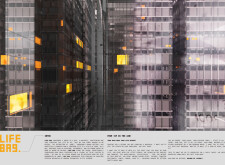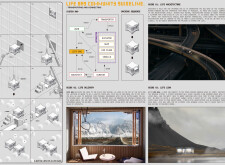5 key facts about this project
### Overview
The "Life Bag" project presents a contemporary residential model designed to address challenges associated with urban living, specifically in densely populated cities. This project emphasizes portability and adaptability, creating a dwelling concept that reflects the evolving nature of home in response to urban densification and limited living spaces. By incorporating modularity and flexibility, the design enables residents to enhance their living experience while accommodating their dynamic lifestyles.
### Spatial Modularity and User-Centric Design
At the core of the "Life Bag" design is the principle of modularity, which allows individual units to operate independently while still being interconnected. This arrangement supports a living environment that can be easily transported, reconfigured, and personalized according to individual needs. Features such as detachable walls, plug-in systems, and smart technologies facilitate a customized layout, enhancing both functionality and user experience. The inclusion of modular furniture configurations emphasizes practicality while maintaining aesthetic coherence.
### Material Selection and Sustainability
The project employs a diverse range of materials that prioritize durability and sustainability. The structural framework consists of pre-fabricated steel or aluminum, known for their lightweight characteristics, which is complemented by a facade of low-emissivity glass that optimizes natural light and energy efficiency. Interior spaces are enriched with sustainable wood veneers and high-performance composite materials, which provide comfort and resilience against frequent changes in usage. Additionally, energy-efficient insulation and emergency systems contribute to the overall safety and sustainability of the design, reinforcing its suitability for contemporary urban environments.






















































